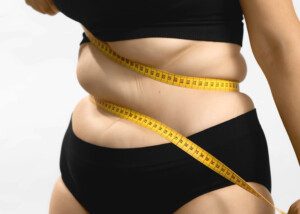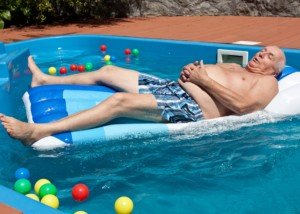Why might a woman’s middle increase with age but her legs and arms stay thin? What can thin younger women do to prevent this imbalance down the road?
If this phenomenon has not (yet) happened to you, you’ve certainly seen it plenty:
A woman has noticeably very slender legs and arms, but is a bit plump in the middle.
You can tell “She used to be skinny.” Why is the middle – the stomach and ab area, along with the waistline – the first to pudge out as a woman gets older?
In fact, it may be the only area that gets bigger with fat.
If you’re younger, and your midsection matches your slim arms and legs, you can actually prevent acquiring a plump stomach and waist in older age that’s out of proportion to trim limbs.
“On average women put on weight as they get older,” begins Dr. David Beatty, MD, a retired general practitioner with 30+ years of experience and an instructor of general medicine for 20+ years.
Why Thinner Women Gain in the Middle As They Age but Not the Legs and Arms
Some, not all, slender and even thin women experience this phenomenon.
“Most of this weight is put on centrally in the abdomen and over the chest,” says Dr. Beatty.
“Fat developing in the abdomen will tend to protrude forwards. It’s easier for the fat to push forward, through the abdominal muscles, rather than push backwards through the spine and the large supporting muscles of the back.
“The abdominal muscles tend to lose their strength as a woman gets older. Pregnancies overstretch these muscles, leaving them weaker.” If you’ve never had kids, though, the situation can still occur.
“Older women are less likely to do the workouts needed to maintain tone in these muscles. Remember the old saying, ‘If you don’t use it you lose it.’
“Osteoporosis [weakened bones] can also be an issue. If this develops the spine often becomes curved and height is lost.
“This can give the impression of the person having a ‘pot belly’ even when they haven’t gained weight.
“Muscle bulk is often lost in the arms and legs as activity levels fall away.
“All these factors result in the belly getting, or a least looking, bigger, and the arms appearing to be disproportionately thin.
“Two relatively common medical causes of a large belly are fibroids and ovarian cysts; these can both be huge.”
Prevention, but Also Solutions if You’re Already Older and Are “Fat only in the Middle”
“To prevent this the most important factor is to avoid excessive weight gain,” says Dr. Beatty. This is more doable than you might think.
“Exercise regimes to maintain the strength of the abs will help, particularly after pregnancy.”
Strength Training Is Key
I witnessed a magical phenomenon when I was a personal trainer: the stomachs of older and otherwise thin or straight-size women shrinking over time, despite no change in diet.
It was magical to them, not to me, because I already knew the science behind this. It’s really simple:
- Excess fat in your middle in an otherwise thin or medium build is actually stored energy.
- This stored energy needs to be put to work.
- Strength training puts it to work, making it vanish.
- It got there in the first place because muscle mass in the back, chest, legs and arms has been lost over the years due to the absence of strength training!
It stinks, but it’s reality: Beginning around age 30, a woman who hasn’t been doing weight workouts starts losing muscle mass.
This results in a slower resting metabolism because muscle eats up energy just to exist. Less muscle = less energy requirements for the body.
Muscle that was once using calories for sustenance is no longer there.
Where will those calories go, even if the woman isn’t overeating? Into storage – and the preferred location is the midsection.
Solution: Lift weights. Prevention if you’re younger? Lift weights. Lift hard and vigorously.
One of my clients, a middle age woman who was on her feet all day as a nurse, had spindly arms and legs but a plump stomach.
She didn’t have to get strong, as in easily hauling 50 pound boxes, in order to lose eight inches off her waistline over a two month period of weight training! She only needed to stick to a twice/weekly program where I had her work HARD.
- Training with weights will restore lost muscle.
- New muscle means more energy is needed to sustain them.
- This energy will be siphoned mostly from where it’s stored in excess: the belly!
- The waist and stomach will then shrink as muscle is gained.
People at the gym would often approach me, grabbing their chubby belly, and ask, “How do I get rid of this? I do a ton of sit-ups; I use the crunch machine; I use cardio machines…”
My answer: “Slam your LEGS. Do squats, leg presses, other leg workouts – just slam the legs.”
They didn’t get this. That’s because people continue to believe that in order to shrink the belly, you must work the abdominal area in a targeted way.
Which requires more fuel? A little motorized bike or an 18-wheeler truck? Think of your abdominal muscles as that little bike, and the big muscles of the legs, butt and back as a giant truck.
All the crunches and sit-ups in the world will never require much fuel, but movements that engage the legs, and especially other muscle groups simultaneously, will dramatically increase your body’s resting energy needs.
If you want to lose the disproportionate fat in your middle, or, if you’re thin all over and want to prevent getting a thick middle, do the following exercises shown below.
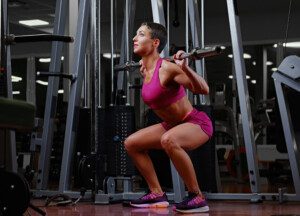
The back squat. Works the legs, butt and core. Freepik.com/fxquadro
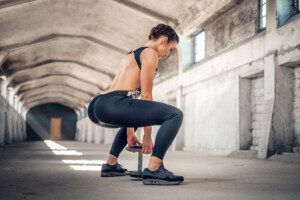
The dumbbell squat. Works the legs, butt and core. Freepik.com/fxquadro
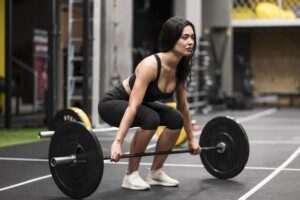
The deadlift. Works the entire posterior chain plus quads, core, biceps and forearms. Freepik.com
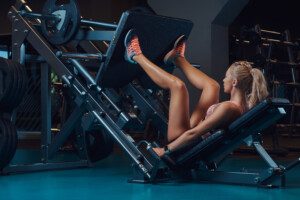
The leg press. Works the legs and butt. Freepik.com/fxquadro

The bent-over dumbbell row. Works the back and arms. Freepik.com/master1305
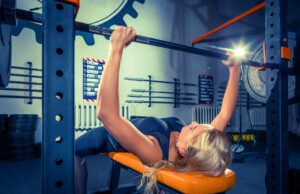
The bench press. Works the chest, triceps and shoulders. Freepik.com/master1305
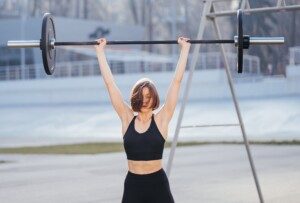
The standing overhead press. Can also be done with dumbbells and kettlebells. Works the shoulders, triceps and core. Freepik.com/ teksomolika
“The chances of getting osteoporosis can be reduced by doing impact exercise, like running,” says Dr. Beatty.
It can also be reduced by building strong bone via lifting weights.
“Avoid smoking and avoid alcohol excess. Being underweight is another risk factor.” Yes, underweight is a risk for future weak, porous bones.
A slender woman who strength trains will have dense bones, while a same-size woman who never picks up any weights will have weaker bones.
Supplementation
“Calcium and vitamin D are important in preventing osteoporosis,” says Dr. Beatty.
“Milk and dairy products are good sources of calcium. Dietary sources of vitamin D are fish and fish liver oils.
“Those of us exposed to sunshine will boost our vitamin D levels, but those living in colder climates may well be deficient during the colder part of the year.
“I’d recommend a multivitamin containing the advised dose of vitamin D if you aren’t getting out much.”
Strength Training Tips
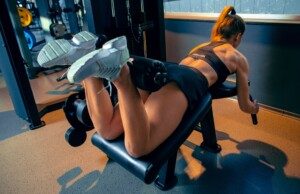
The leg curl. Works the hamstrings. Freepik/master1305
• Use a weight load that makes eight reps possible with effort, but more than 12 extremely difficult.
• If you can do more than 12, increase the load, but make sure you can still do at least eight.
• Rest at least a minute between sets. If you need another 30 seconds, take it.
• Use proper form, especially with the deadlift and back squat.
• Lifting weights will not bulk you up, especially if you’ve been a “hard gainer” all your life.
• A slender or straight-size woman doesn’t have to get a plump belly as she gets older.

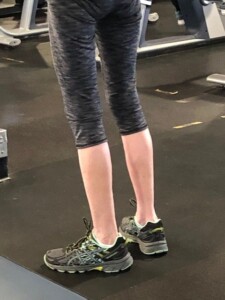
 Dr. Beatty has worked in primary medicine, surgery, accident and emergency, OBGYN, pediatrics and chronic disease management. He is the Doctor of Medicine for
Dr. Beatty has worked in primary medicine, surgery, accident and emergency, OBGYN, pediatrics and chronic disease management. He is the Doctor of Medicine for 